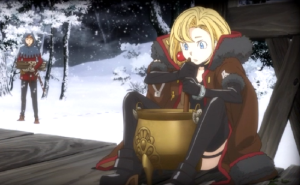
“This broth needs something to firm it up…another rape implication? No, I know! A pedophilia scene!”
Maria the Virgin Witch has emerged as one of the more popular animes of the season and it’s very easy to see why. The series is a prime example of something we simply don’t see very often in Western animation. It tackles apparent hypocrisies in the actions of Christians and the Christian church from the very first episode while defending an openly defiant heretic. By the third episode, Maria is already offering commentary on justice, war, religion, and death. The church — and Archangel Michael himself — serve as looming enemies.
That’s not to say that Maria’s insights are particularly thought-provoking considering the audience is intended to be adults. Despite its desire to delve into very human places, Maria constantly shies away from getting too deep (or preachy) with humour, which isn’t all that funny most of the time. The repeated gags about blowjobs are less funny than the pun I just made to comment on them. Using homosexual clergy as the punchline to jokes? Forget the beating, just put that dead horse in a blender and make a smoothie.
Choosing France during the Hundred Years War as a setting makes for some very interesting history. Combine this with the presence of many pantheons including Norse and Celtic deities and you get a world glittering with nuggets of lore. However, in many ways these serve no purpose. Using the obscure Celtic god Cernunnos as a jealous and power-hungry deity seems like a cowardly way of injecting a totally-not-Lucifer character. The valkyries watching English and French battles have no historical reason to be present and ultimately only serve to show that, hey, they exist. Reappropriating religious mythos just because they’re neat is hardly something new to Japanese animation (Shinji, get in the fucking robot!) but it would be refreshing to see it done with some reasoning behind it.
The animation is also nothing impressive. It’s standard two tone MS Paint shading at its finest. There are some large scale battle scenes in which it is easy to see where corners were cut. The artists understandably hope your attention is focused away from a great number of static frames during key moments. The stoney expressions on Maria’s owl familiars often leave them looking like they took a gamble on a fart and lost during scenes that are supposed to be serious.
The music is often distractingly bad. Michael is probably always in such a hurry to leave because he can’t stand to stick around and listen to his own theme song. The main theme is a standard B-class adventure tune — forgettable in every way. The closing theme features owls bobbing back and forth to a song that sounds like it will haunt some shy Japanese child with memories of that time he went to his school dance and just couldn’t find the courage to shuffle away from the wall.
Having a virgin as the title character should make it no surprise that the innuendo is strong with this one. Maria is often naked for no reason and she keeps a succubus around who looks like she’s ready to audition for a part in The Fifth Element…yet Maria doesn’t seem to understand exactly what a succubus does. We’re spared from a male harem and introduced to Maria’s single love interest in the very first episode. While this does take away the element of mystery when it comes to the romance, it lets the show focus on the main plot and keeps filler to a minimum.
Overall, Maria is watchable but not something that’s going to be terribly memorable. It has enough interesting characters that the series could continue on in a satisfying way for quite some time, but unless the title character becomes more dynamic, this show will become very redundant quite quickly. With so few plain ol’ humans around, it’s also difficult finding characters to which you can genuinely relate.
Tentative Rating: 6.5/10
Series Info:
Title: Maria the Virgin Witch (Junketsu no Maria)
Original Source: Manga
Source Writer: Masayuki Ishikawa
Source Publisher: Kodansha
Director: Goro Taniguchi
Producer: Y. Kisara, K. Nishiwawa, N. Shimizu et al.
Writer: Hideyuki Kurata
Music: Koda Masato
Studio: Production I.G.
Run Start: January, 2015.
Review Date: 03/2015
Episodes Reviewed: 01-03







Pingback: SPRING SEASON IN REVIEW – 2015 | betteranime
Great blog you have hhere
LikeLike